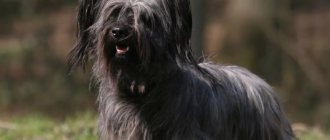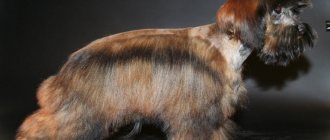The breed of dog in the film "Beethoven" is St. Bernard. The dog played one of the main roles in the film; it is a real purebred St. Bernard, which captivates with its size and friendliness.
In the sequel, in the film “Beethoven 2”, the St. Bernard appears with his puppies. According to the producers, over 100 St. Bernard puppies participated in the casting for the roles of the four puppies (Tchaikovsky, Chubby, Dolly and Mo).
Saint Bernards are distinguished by their size; they are large dogs, but at the same time kind and balanced. Their fur can come in many colors, but Beethoven featured a white dog with tan spots.
Parents should also know that there is subtle humor in comedy, but there is also slapstick. Inept, repeated humiliation by adults can irritate some parents. Don't be surprised if kids start pestering you about this dog after watching the movie.
Care
St. Bernards' daily requirements include short runs and moderate walks. It is better to raise a St. Bernard outdoors. Large puppies that are raised indoors are prone to hip problems.
Saint Bernards do not tolerate heat, in fact they love cold weather, so they simply need access to a yard or garden. The coat of these dogs will require weekly brushing, and more often during shedding. In addition, many St. Bernards have a tendency to drool.
Brief description of the breed
Having made a choice in favor of St. Bernard, the scriptwriters were not mistaken. The Dogs of Saint Bernard, as they are often called in literature, are covered in fame not only thanks to the film industry. A strong, large and very hardy dog became famous several centuries ago.
A powerful dog with a large head, small ears, and a very large collar, he has medium-length hair with a thick, warm undercoat. The color is white with yellow and brown or black spots. There are also long-haired St. Bernards. These dogs have powerful jaws, muscular paws, and a well-developed chest.
History of the breed
The breed got its name thanks to the monk Bernard, who founded a shelter for travelers in the Alps at the pass, later known as Grand Saint Bernard. The monastery became a refuge from storms, avalanches, piercing winds and robbers.
In it, by crossing with Tibetan mastiffs, dogs adapted to local conditions were bred. They were able to sense the approach of an avalanche, accompanied the monks on the road and protected them. It was the Saint Bernards who were sent by the monks to look for lost frozen travelers in the mountains under snow rubble and avalanches.
St. Bernard rescue dogs had kegs of hot drink tied to them, which warmed the victims.
Barrels of hot drink or wine were attached to the collar of the giant, who was distinguished by his intelligence and keen sense of smell, to support weakened and frozen people.
Important. Since the 17th century, representatives of a unique breed have participated in rescue operations, finding lost travelers and helping them get to safety. Barry (Bear) was the name of the most famous representative of this breed, who saved more than 50 people, among whom was even a child, whom the dog carried 5 km to the monastery.
Character of the St. Bernard breed
Formidable watchmen and protectors, despite their frightening appearance, St. Bernards have a good-natured disposition, they are devoted to their owners, are highly trainable, and in a calm state they seem like hulks. But at the slightest threat they turn into a formidable weapon, sweeping away everything in their path, and practically do not feel pain in the heat of battle.
They are especially gentle towards children, turning into real nannies.
Main qualities of the breed
The advantages of the breed include a calm temperament, easygoing behavior, love for children, friendliness and sociability.
Saint Bernards are very calm and peaceful dogs.
The disadvantages include dislike for small breeds of dogs, reluctance to be alone, and excessive salivation. Saint Bernards cannot tolerate aggression or anger; even when trained, they require special gentle treatment, otherwise they become stubborn. They have a short lifespan - up to 8 years.
Important. Dogs of a respectable age suffer from arthritis, heart disease, and are not spared by oncology.
The purpose of St. Bernard
These service dogs have been used for:
- accompaniment;
- rescue in deep snow;
- carrying heavy loads;
- guard service;
- security
Today they have turned into protectors and loyal friends, companions. They are still used for guard duty, they work in the mountains, at the sites of tragedies. But most of these dogs live in ordinary home conditions. They are good both for families with children and as faithful friends for lonely elderly people.
Saint Bernards are rescuers, guard dogs and excellent companions for the whole family.
They need plenty of space for walking and long walks. People in an apartment may feel unwell due to the heat and lack of space, so it is better to take the dog into a private household or walk for several hours a day, giving the necessary physical activity.
Dimensions: height and weight
Height at withers:
- male - at least 70 - 80 cm;
- female - up to 65 cm.
Dog weight:
- male 75 – 80 kg;
- female – 60 -70 kg.
The dogs are famous for their size, but despite their mass, they are very harmoniously built, with a straight, wide back, powerful neck, high paws and a sunken belly.
physical characteristics
This is one of the hardiest dog breeds, capable of withstanding both severe frosts and heat, with a very stable psyche. There is no causeless aggression towards strangers in them, but they feel the mood of the owner very subtly, are able to support, distract, and are extremely smart.
Saint Bernards are very hardy and can withstand even severe frosts.
Saint Bernards are also known for being one of the largest dog breeds.
History of the breed
Originating from the Molossian Dog, St. Bernards evolved into amazing dogs that began saving the lives of travelers in the mountains between 1660 and 1670. They were originally used as companions and guard dogs that also pulled carts. But then the monks discovered that these dogs were exceptional trackers in the snow. St. Bernards tracked lost travelers, licked his face, lay next to him to warm him and help revive him. The dog has served this purpose for over 300 years and has saved at least 200 lives.
The most famous St. Bernard dog, Barry, saved about 40 people. Before Barry's death, these dogs were called "rescue dogs." But after the death of the famous animal, they began to be called barrihund.
In the early 19th century, many dogs died due to disease, harsh weather conditions and inbreeding. In 1830, some of the remaining St. Bernards were crossed with Newfoundlands, creating a long-haired breed. It turned out that this coat can protect a dog in very cold climates, but it also becomes a hindrance to movement in the snow. Thus, long-haired St. Bernards were not used for rescue purposes.
Saint Bernards were brought to England in the 1850s and were first referred to as “sacred dogs.” By 1865, the breed was commonly referred to as the St. Bernard, and was registered with the American Kennel Club in 1885. Currently, Saint Bernards are extremely popular in the United States and are one of the most popular giant dog breeds around the world.
Beethoven - Saint Bernard dog breed
The Saint Bernard breed was the first to be included in the Swiss Stud Book. This happened in 1884 after the Swiss St. Bernard Club was founded. The stud book helped to improve the breed, and as a result, the Saint Bernard breed was declared the national Swiss dog.
Commander (dog): Hungarian shepherd breed
The dogs, the ancestors of modern St. Bernards, have been known in the Alps for a long time. There was a monastery on the border in the mountains between Italy and Switzerland. Nearby, in 1049, a shelter was built for travelers across the border pass, which became known as Great St Bernard Hospice in honor of the monk who founded the community. Large dogs lived in the monastery - a type of Molossian herding breed brought to the Alps by the Romans. The monks' dogs were ordinary gray draft animals with fleas in their fur, but they were valued for their ability to find travelers buried in avalanches.
For your information! The biography of one of the dogs named Barry became known throughout the world, because he saved the lives of several dozen people, according to some sources, up to 100 people. A monument was erected to him at the Cimetiere des Chiens dog cemetery in France, and his body is kept in the Bern History Museum.
The dogs who lived with the monks never felt sorry for themselves when saving people. But they did not receive any special training for working in the snow. The actions of the old dogs set an example for the young ones, so the animals themselves often became victims of the elements. From 1816 to 1818 In the Alps, many dogs died due to abnormal snowfalls. To preserve the breed, the surviving animals, along with the Newfoundlands, were involved in the selection of a new variety of dogs called St. Bernards.
Note! There is a legend that monks hung a barrel of hot brandy around the necks of rescue dogs so that the person they found could warm up. But the servants of the museum dedicated to the breed in Martigny (Musee et Chiens du Saint Bernard) deny this fact.
Musee et Chiens du Saint Bernard
How much do they cost and how to choose a St. Bernard puppy?
If you have weighed the pros and cons, and also studied the conditions of keeping such a large animal, then you should not immediately run to the poultry market. In such places you can buy a “fake” and it is not similar to the breed - this is only a small of the possible problems. The animal may be sick or have a character unusual for the breed. When purchasing a puppy similar to Beethoven, do not expect the same character from him, because the dog’s behavior is the result of the work of specialists in breeding the breed from the film “Beethoven”.
Features and character
The animal doesn’t care about the heat: on the contrary, it likes cold weather, so it needs access to the yard. Most St. Bernards are prone to drooling.
They are very obedient, have absolutely no conflicts and will never allow themselves to disobey their beloved owner. Such dogs are naughty only when they are babies. An adult St. Bernard behaves with dignity, shows good manners and calmness. Saint Bernard loves children, he is also called a children's nanny.
Children can cuddle, ride on this dog, kiss and hug it - Beethoven likes all the joyful manifestations of feelings coming from the owners. What kind of dog would allow himself to be treated like this? In fact, there are not many breeds similar in character.
Beethoven is always ready to help both his masters and strangers, in general, everyone who needs it. This is an invincible friend and protector in dangerous situations (whether an attack on the owner, robbery, etc.).
The Saint Bernard gets along well not only with children, but also with animals: he communicates without problems with cats, horses and representatives of his dog tribe. And most importantly: do not leave your St. Bernard alone for a long time. Loneliness is difficult for a dog to endure, and it greatly “traumatizes” it.
Famous representatives of the Beethoven dog breed
After looking through history, you can learn about many famous dogs of the breed from the film “Beethoven”. Most of them have achieved recognition due to their working qualities, but there are representatives who have gained popularity for their appearance.
Saint Bernards in the Guinness Book of Records
The huge dog Benedictine entered the book of records for his enormous weight, which reached 140 kg! The dog Hercules, who weighed 128 kg and had a neck girth of 96.5 cm, is slightly inferior to his giant relative.
It was the St. Bernards that were included in the book as one of the strongest dogs in the world. The male Raittes Brandy Bear and the female Barbara managed to drag more than 2 tons of weight.
Barry, known throughout the world, became a record-breaking rescuer, because during his life he managed to pull 40 people out of the clutches of death. He lived in the 1800s at the Saint Bernard Monastery. The most famous rescue story was how Barry pulled a little boy from an ice cave whose mother had died in an avalanche.
"Little Bear" on a Norwegian ship
In the middle of the last century, a small St. Bernard appeared in the family of a whaling ship captain, who was named Bamsi, which means “little bear.” During the Second World War, the already experienced tailed sailor serves on a patrol ship of the Norwegian army. He became famous for carefully guarding his comrades, rescuing them from various troubles, and reconciling them during quarrels. The government made Bamsi a symbol of the Norwegian resistance, and after his death a monument was erected to the faithful dog.
Film actors and heroes of works of fiction
- Stephen King wrote a wonderful book about a St. Bernard, Cujo , who contracted a serious illness. A film was made based on this book.
- Astrid Lingren, in his work “ On the Island of Saltkrok, ” mentioned the pet of one of the heroines, who also belongs to the St. Bernard breed.
- The St. Bernard-Collie mix became one of the heroes of Jack London's The Call of the Wild
- St. Bernard Lel was one of the key characters in the Strugatsky brothers’ story “ Hotel “At the Dead Climber” .”
- Felix is the Family's Best Friend was released , the main character of which was a representative of this strong breed.
- The heroine of the Soviet film “ Where are you, Bagheera?” "became a spectacular St. Bernard.
- In the story of Peter Pan, there was a four-legged St. Bernard dog, Nana.
- Maxipes Fic was published in Czechoslovakia , describing the adventures of a giant St. Bernard.
History of the breed
The homeland of the Saint Bernard is Switzerland. The name of the breed in translation sounds like “St. Bernard’s dog.” The origin of the name has its own history. In the eleventh century, a monk named Bernard founded a refuge for travelers at the Great St. Bernard Pass. The territory where the shelter was located was at an altitude of about 2472 m.
This section is very dangerous; travelers on the trail faced many dangers: robbers, strong winds, avalanches, steep mountain crossings. At Bernard's shelter, travelers had the opportunity to rest, eat and sleep before continuing on the dangerous path. Local dogs were called St. Bernards; they were irreplaceable helpers for their owners, and later became unrivaled rescuers.
The origin of St. Bernards is not precisely established. According to some information, representatives of this breed descended from fighting mastiffs, which arrived in the Alps along with the Romans. There is also another version, according to which St. Bernards descended from Asian mastiffs (Tibetan mastiffs). In both the first and second cases, mastiffs were crossed with local dogs, and the resulting puppies were named St. Bernards.
In the seventeenth century, the monks, appreciating the abilities of the St. Bernards, decided to use them to save people caught in avalanches. The fact is that representatives of the breed have an exceptional sense of smell, thanks to which the dog could smell a person under a thick layer of snow. These dogs also have thick skin that protects them from snow, ice and frost. Saint Bernards were often taken on the road with them. They not only protected their owners from predators and robbers, but also warned of approaching avalanches. A dog of this breed is able to sense an avalanche 20 minutes before it occurs. This gift helped save many lives.
The ancestors of St. Bernards were different from their modern descendants. They were not so heavy, their physique could be called more graceful. This made it easier to move through the snow and made the dogs agile and fast. Today's representatives of the breed are much heavier, more powerful, but at the same time they are less agile.
The breeding of purebred St. Bernards began in earnest at the end of the nineteenth century. Even though mountain rescuers now have all sorts of equipment at their disposal, dogs are still used in rescue work. But in most cases, St. Bernards are excellent guards, companions, accompanying dogs and just pets.











